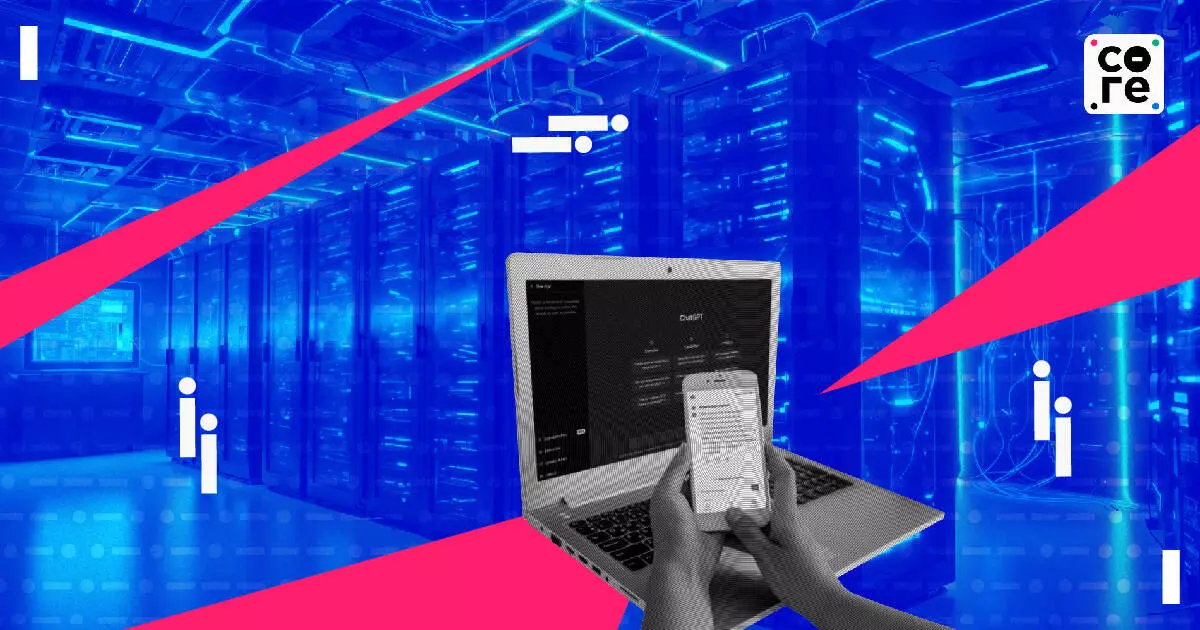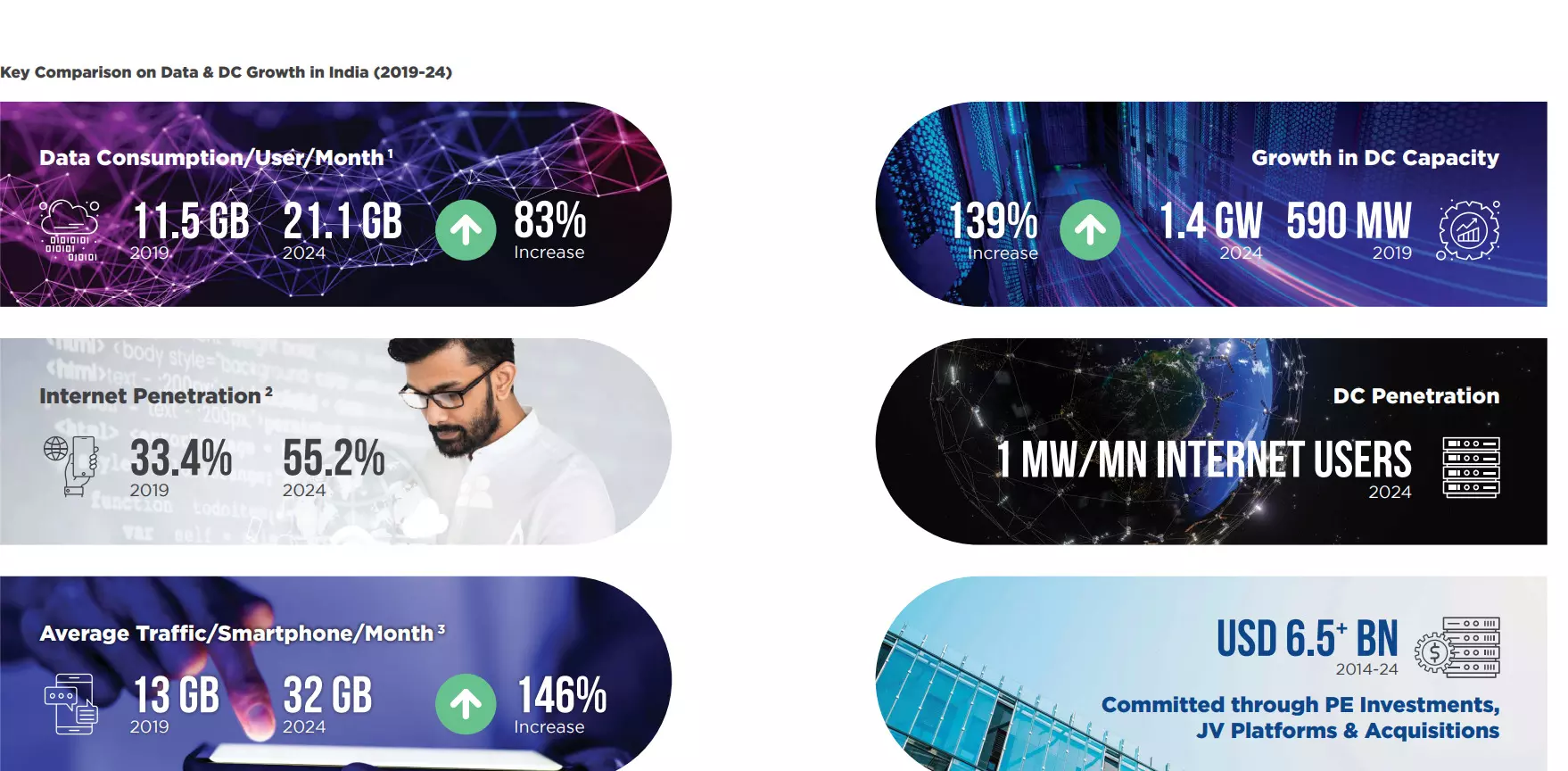
'Necessary Evil': Why India Needs Data Centres Despite Environmental Impact
Sharad Sanghi, the founder of India’s first data centre company Netmagic, also spoke to The Core Report Special Edition about how artificial intelligence was bringing in a third wave of growth for data centres.

As the world animatedly jumped on the Ghibli bandwagon, ChatGPT’s server crashed temporarily, proving that data centres matter, a lot. In India, too, data consumption has jumped manifold in the past few years. Data centre capacity in the country jumped by a whopping 139% between 2019 to 2024, as per an Anarock report. And as Indians stream TV shows, buy and pay digitally, there is a runway for growth.
“Data centres is one industry where we've ended up beating the analyst estimates for the last few years consistently. People are talking about doubling in the next three, four years. I won't be surprised if we double faster. We'll probably double in two years, if not three,” Sharad Sanghi, the founder of India’s first data centre company Netmagic, told The Core Report Special Edition.
Who’s India’s Top AI Spender?
The next spurt of demand for data centres will come from the zeitgeist of the day – artificial intelligence (AI). As per Sanghi, one of the top consumers of AI-driven data centre usage is the government of India. Almost a fourth of the data centre capacity in general is used by them. They’re on the front foot with AI too.
“They (the government) are large consumers of AI. Government departments want to use AI,” said Sanghi.
In addition to consuming, they’re also playing a large part in popularising it. They have set up three centres of excellence �...
As the world animatedly jumped on the Ghibli bandwagon, ChatGPT’s server crashed temporarily, proving that data centres matter, a lot. In India, too, data consumption has jumped manifold in the past few years. Data centre capacity in the country jumped by a whopping 139% between 2019 to 2024, as per an Anarock report. And as Indians stream TV shows, buy and pay digitally, there is a runway for growth.
“Data centres is one industry where we've ended up beating the analyst estimates for the last few years consistently. People are talking about doubling in the next three, four years. I won't be surprised if we double faster. We'll probably double in two years, if not three,” Sharad Sanghi, the founder of India’s first data centre company Netmagic, told The Core Report Special Edition.
Who’s India’s Top AI Spender?
The next spurt of demand for data centres will come from the zeitgeist of the day – artificial intelligence (AI). As per Sanghi, one of the top consumers of AI-driven data centre usage is the government of India. Almost a fourth of the data centre capacity in general is used by them. They’re on the front foot with AI too.
“They (the government) are large consumers of AI. Government departments want to use AI,” said Sanghi.
In addition to consuming, they’re also playing a large part in popularising it. They have set up three centres of excellence — for agriculture, health, and sustainable cities. There are reports of them mulling another centre for education.
“I think the government played a very positive role. They set up the AI mission, where they are looking at subsidising GPU (Graphics Processing Unit) capacity in a public-private partnership, and also funding research,” he said.
The government however is the second largest driver of data centres via AI. Research institutes are the top-most customers, with their research and fine tuning. The next is native AI startups who have raised funding and are looking for AI enterprises and require a lot of GPU capacity. Then comes enterprises across sectors like BFSI, healthcare, logistics. retail etc.
As some of these promises come to hold, the capacity requirement will expand. As per an Anarock report, the sector received as much as $6.5 billion in commitments in the last decade. It has long since captured the imagination of private equity, UHNIs and more institutions.
Humble Beginnings
The Indian data centre business, which is now worth $10 billion and generated a revenue of $1.2 billion in FY24, as per Anarock, had very humble beginnings.
Sanghi, who came back to India from the US in 1995, was then consulting for fledgling internet companies like Sify, as the Indian government opened up the internet sector to private companies.
During his US stint, Sanghi met BV Jagdish and KB Chandrasekhar, who started the first data centre company in the world, Exodus Communications, in the US. Inspired, Sanghi built India’s first data centre of 3,00,000 square feet in Mumbai’s Goregaon, in October 2000, as the world was coming off the big Y2K scare.
Back then, most Indian companies would dedicate a room to the server with very little maintenance and were more comfortable having the server in-house. They would take one rack or half a rack of space. They had to ‘design’ quarter racks with locked cabinets etc to accommodate the measly demand.

Natural Disasters Plus Hyperscalers
Two natural disasters in Mumbai and earthquake in Bhuj, brought the dark reality of ‘saving’ data to the fore. By 2008, data centres started getting its biggest customers – the banking, insurance and financial companies.
The second wave of growth was from hyperscalers like Google, Amazon, Microsoft, Oracle, Meta — which created a mad rush for servers in 2015. The days of racks are long gone. Now, NTT, the company which acquired Netmagic, sells entire buildings if not campuses to hyperscalers.
But the third wave of AI growth shows tremendous promise that could outdo the earlier growth phases. The energy density per rack has gone up due to AI workloads from a modest 20-30 kilowatts per rack, to over 100 kilowatts per rack. The rise of generative AI with real-time needs adds another dimension to this growth story.
To cater to this demand, the sector is scaling up mountingly in this third phase. The sector which had 1.4 GW of capacity across 20 million square feet of space is expected to grow to 2.6 GW by 2027, as per Anarock report.
Location, Location & Electricity
If location, location and location are the three ways to measure real estate, data centres, known as a sub-sector of real estate, are contingent upon electricity as much as location.
So much so, data centres are now measured in megawatts, a unit of electricity. The industry, of course, refers to it as IT power. “The two lifelines of data centres are power and fibre,” explained Sanghi.
That’s what has made Mumbai and Chennai data centre hubs in spite of their humid climate, that requires extra efforts to cool them. Together, these two cities hold 70% of data centre capacity – their access to undersea cable as well as reliable power supply adds to it.
Mumbai in particular has two more advantages going for it – local demand which provides lower latency to the large number of users, as well as talent which is best available here, as per Sanghi.
Experts predict that data centres might also spread geographically, again thanks to AI. “Gen AI moves into real time application, low latency processing becomes critical and this will push the need for edge data centres across the country,” the Anarock report predicted. Some of these centres are expected in tier II cities like Jaipur, Ahmedabad, Vizag, Kochi, Bhubaneshwar, Lucknow and Patna.
Power Usage Efficiency
Data centres go much beyond offering mere space, power connection and maintenance. At any given point in time, a 3,00,00 square foot data centre capacity uses up 45 MW of power. They also offer energy efficiency — through a process called Power Usage Efficiency (PUE) — and manage the large amounts of heat generated from these facilities.
Sanghi explained that the energy efficiency that a data centre achieves is better than what companies can achieve at their own centres. “Data centres consume a lot of energy, but they are actually good. If I were to just imagine this workload was just distributed in everybody's offices, the PUEs in these typical office data centres are higher. For every one unit, they are wasting one unit,” he adds.
The sector is also making rapid strides in PUEs. The latest two methods in use are liquid cooling as well as direct-to-chip cooling. The Power Usage Efficiency (PUE) of traditional designs is anywhere between 1.7-1.8.
“With direct-to-chip cooling, we have achieved a PUE of 1.2. With liquid immersion cooling, it went as low as 1.08. However, the problem with liquid immersion cooling is that the servers need to be something that can be immersed. If the servers cannot be immersed, then you cannot use liquid immersion cooling. So the most popular technology right now, direct to chip cooling for AI workloads,” Sanghi explains.
Large data centre companies like NTT, which hold little over a fifth of the country’s capacity, use ways to reduce their environmental impact. They generate 45-50% of power needs via green sources like solar and wind, feed it to the grid and get power wheeled back. They intend to turn carbon neutral by 2030.
Internationally, a few companies are also mulling setting up a micro nuclear grid to support this enormous power-guzzling sector. But are data centres destroying the planet, even as heat waves have turned the order of the day? “In this day and age, everything runs on the cloud, and you can't be without data centres. It's a necessary evil, right?” Sanghi sums it up.
Sharad Sanghi, the founder of India’s first data centre company Netmagic, also spoke to The Core Report Special Edition about how artificial intelligence was bringing in a third wave of growth for data centres.

